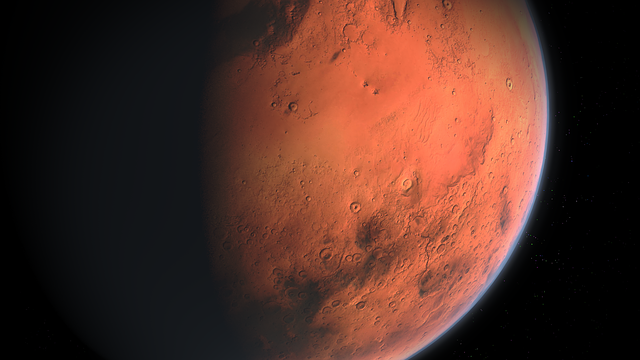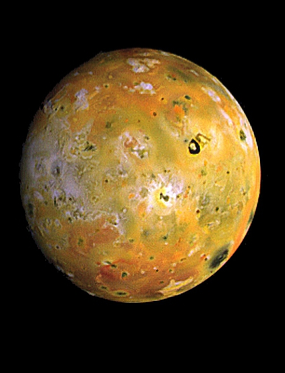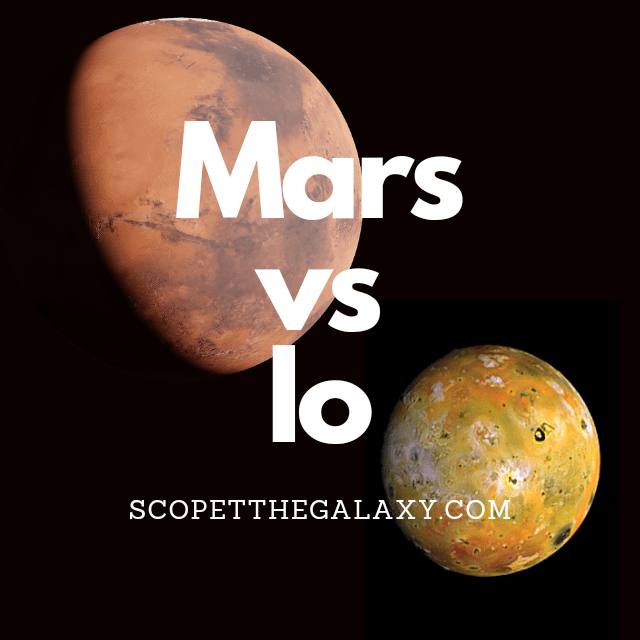*This post may contain affiliate links. This means we may make a commission if you purchase an item using one of our links*
The main differences between Mars and Io is that Mars is the 4th closest planet to the Sun whilst Io is a natural satellite and is joint 5th with the planet it orbits (Jupiter), Mars is bigger with a diameter of 6,779km whilst Io’s diameter is 3,643km, Mars has 2 moon orbiting it whilst Io has 0 and Io is currently the most volcanically active body in our solar system whilst Mars has 0 activity.
If you want a more detailed look at the differences between the two along with a breakdown of these two celestial bodies below, continue reading.
What Is The Planet Mars?
Table of Contents

Mars, also known as the red planet, is the celestial object that’s the front runner in our entire solar system to become a possible new home for us if terraformed. It is also the 4th farthest planet from the Sun and is one of 4 main line terrestrial planets (not including Pluto) in our solar system.
This means that one year on Mars will take roughly 687 Earth days and a day on Mars is roughly the same as Earth at 24 hours and 37 minutes. It’s axial tilt is also very similar to that of Earth where it is positioned around 25 degrees to the right.
It may not be the largest terrestrial world in our solar system as its diameter is only 6,779km but, it does have the most moons amongst the normal terrestrial planet where two, namely Deimos and Phobos, are currently orbiting the red planet.
Like Earth and the other terrestrial worlds, Mars does have an atmosphere, certainly more visible than that on Mercury but, when compared to Earth’s it is merely 1% of its volume.
As a result it is more susceptible to larger debris striking its surface and is unable to trap in too much heat either. This is why it’s on the colder side with a temperature of around -65 degrees Celsius on average. On the contrary its core is significantly hotter at 1,350 degrees Celsius.
Mars is probably the most explored planet outside of our own, with a multitude of rovers like Sojourner (1997–1997), Opportunity (2004–2018), Spirit (2004–2010), Curiosity (2012–), and Perseverance (2021–) that have landed on the Martian soil to explore it.
Billionaires like Elon Musk and even Jeff Bezos are trying for an opportunity to genuinely have astronauts land on the Martian soil, possibly as early as 2029 so, Mars clearly has a lot interested in its terrain, as a potential substitute for Earth in the future.
What Is The Moon Io?

The Moon Io – also known as Jupiter I – is the third largest of the Galilean moons, which has the closest orbit to Jupiter. It is the fourth-largest moon in our solar system by size – with a diameter of 3,643km – but has the highest density of all moons in the Milky Way.
In addition, Io has the strongest surface gravity of all moons and the least water by atomic ratio compared to any other astronomical object in our solar system.
Perhaps the most interesting feature of this lunar body is the 400 active volcanoes on its surface, which make it the most volcanically active object in the Milky Way; some of these volcanoes can exude plumes of sulfur to a height of several hundred miles.
The reason for this intense activity is the tidal heating caused by friction in the moon’s interior. Thanks to Io’s proximity to Jupiter, it finds itself caught between the gravity of its planet plus the two nearby moons – Ganymede and Europa. And this creates extreme tidal forces.
A side effect of these tidal forces is heat, which keeps most of Io’s crust in liquid form. Because of this, the surface of Io experiences a constant state of renewal; sites once home to large craters are slowly filled with molten lava and liquid rock.
While the complete makeup of Io’s surface is not yet defined, theories suggest that its main component could be sulfur and sulfur compounds because of the varied coloring. Silicate rock could also be a likely component as it would account for the high temperatures.
Io orbits Jupiter from a distance of around 422,000km, with an orbit that takes 42.5 hours to complete. Sitting 778,000,000km from the Sun, the surface temperature of this planet sits around -130 degrees Celsius. But due to the intense volcanic activity, the lava flows can reach temperatures of 1649 degrees Celsius, which is far hotter than anything on Earth.
Similarities Between Mars And Io
Io and Mars do have their odd few similarities, which in this case includes the below:
- Both have a hotter central core.
- Both have an atmosphere and a rocky surface.
- Both are a spherical shape.
- Both are part of the same solar system.
- Both have no rings surrounding them.
- Neither have tectonic plate activity.
Differences Between Mars And Io
As for the differences between the two, they include the following:
- Io is smaller with a diameter 3,643km compared to Mars’ 6,779km.
- Mars is a planet whilst Io is a natural satellite.
- Mars has 2 moons whilst Io has 0.
- Mars orbits the Sun in a nearly circular pattern whilst Io orbits Jupiter and the Sun elliptically .
- A day on Mars takes 24 hour and 37 minutes whilst a day on Io is 42 hours.
- Mars orbits the Sun in 687 days whilst Io orbits the Sun in 12 years and Jupiter in 42 – 43 hours.
- Mars has an axial tilt of 25 degrees whilst Io’s axial tilt is practically 0 degrees.
- Io’s average temperature is -130 degrees whilst Mars has an average temperature of -65 degrees Celsius.
- Io’s atmosphere is near enough non-existent composed mostly of sulfur dioxide whilst Mars has an atmosphere that is 1% the thickness of Earth’s and composed of 95% carbon dioxide with smaller amounts of nitrogen, molecular carbon monoxide and argon.
- Io’s gravity is 1.796 m/s² compared to Mars’ that is 3.721 m/s².
- Mars has a mass of 6.39 × 10^23 kg whilst Io’s mass is 8.93 × 10^22 kg.
- Io has a density of 3.53 g/cm³ whilst Mars has a density of 3.93 g/cm³.
- Io is the most volcanically active entity in our entire solar system whilst Mars has no active volcanoes on its surface.
Summary
Although Mars and Io have some similar features such as their terrestrial composition, their lack of tectonic activity and the fact both are part of the same solar, they still have a large variety of differences between.
Whether it be in regards to their mass, size, density, the number of objects that orbit them, volcanic activity and more, Mars and Io have completely different functions within the solar system as a whole and as a result operate distinctly from each other.

